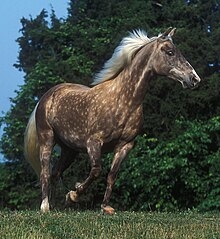Rocky Mountain Horse

Silver dapple-colored Rocky Mountain Horse
|
|
| Other names | RMH |
|---|---|
| Country of origin | United States |
| Traits | |
| Height |
|
| Color | Any solid color allowed, but Silver dapple coloration preferred |
| Distinguishing features | Singlefoot ambling gait |
| Breed standards | |
The Rocky Mountain Horse is a horse breed developed in the state of Kentucky in the United States. Despite its name, it originated not in the Rocky Mountains, but instead in the Appalachian Mountains. A stallion, brought from the western United States to eastern Kentucky around 1890, began the Rocky Mountain type in the late 19th century. In the mid-20th century, a stallion named Old Tobe, owned by a prominent breeder, was used to develop the modern type; today most Rocky Mountain Horses trace back to this stallion. In 1986, the Rocky Mountain Horse Association was formed and by 2005 has registered over 12,000 horses. The breed is known for its preferred "chocolate" coat color and flaxen mane and tail, the result of the relatively rare silver dapple gene acting on a black coat, seen in much of the population. It also exhibits a four-beat ambling gait known as the "single-foot". Originally developed as a multi-purpose riding, driving and light draft horse, today it is used mainly for trail riding and working cattle.
Rocky Mountain Horses stand between 14.2 and 16 hands (58 and 64 inches, 147 and 163 cm) high. Any solid color is accepted by the registry, but a dark brown color called "chocolate" with a pale, "flaxen" mane and tail is preferred. This coloration is the result of the relatively rare silver dapple gene acting on a black base coat. Although uncommon, this gene has been found in over a dozen breeds, including the Rocky Mountain Horse. Minimal white markings are accepted by the registry, although leg markings may not extend above the knee. The physical characteristics are somewhat variable, due to the disparate breeds that created the Rocky Mountain Horse. The Rocky Mountain Horse is known by enthusiasts for its hardiness and ability to withstand winters in the mountains. It is also praised for its good nature and affinity for humans. Rocky Mountain Horses have the highest risk of any breed for the genetic ocular syndrome multiple congenital ocular anomalies (MCOA), originally called equine anterior segment dysgenesis (ASD). MCOA is characterized by the abnormal development of some ocular tissues, which causes compromised vision, although generally of a mild form; the disease is non-progressive. Genetic studies have shown that the disorder may be tied to the silver dapple gene, as most horses diagnosed with MCOA carry the gene.
...
Wikipedia
